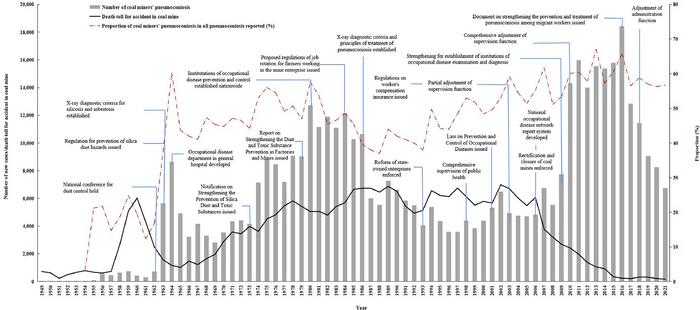At work, coal miners are constantly exposed to silica or coal dust, which tends to settle in their lungs. This irritates the lungs, causing inflammation, fibrosis, and breathing problems. Although CWP is caused by dust inhalation inside and around coal mines, other contributing factors such as geological and mining parameters, mining technology, dust particle characteristics, and monitoring also play significant roles in its epidemiology. Clearly, the social determinants of health (SDH) or the environmental conditions that affect health, functional, and quality-of-life outcomes play a pivotal role in determining the incidence of CWP, which is now a major public health concern.

Credit: Chinese Medical Journal Pulmonary and Critical Care Medicine, published by Elsevier B.V. on behalf of Chinese Medical Association.
At work, coal miners are constantly exposed to silica or coal dust, which tends to settle in their lungs. This irritates the lungs, causing inflammation, fibrosis, and breathing problems. Although CWP is caused by dust inhalation inside and around coal mines, other contributing factors such as geological and mining parameters, mining technology, dust particle characteristics, and monitoring also play significant roles in its epidemiology. Clearly, the social determinants of health (SDH) or the environmental conditions that affect health, functional, and quality-of-life outcomes play a pivotal role in determining the incidence of CWP, which is now a major public health concern.
China, the world’s largest producer and consumer of coal, also has the most coal miners. Despite efforts over the past seven decades, cases of CWP continue to rise in the country and no studies report the direct analysis of available CWP data. Now, researchers from China have addressed this issue by comprehensively analyzing the epidemiology and social determinants of CWP across the country. Using data collected from coal miners (i.e., those who were working in or had retired after working in the coal mining and dressing industry) in China between 1949 and 2021, the team determined the annual incidence rate, 20-year prevalence rate, and the incidence rate of CWP per million tons for that period. Their study, recently published in Chinese Medical Journal Pulmonary and Critical Care Medicine, carefully dissects historical CWP data from a broader standpoint.
Senior author Huanqiang Wang from the National Institute of Occupational Health and Poison Control, China, sets some background to their work: “The Chinese government and society attach great importance to the prevention and control of pneumoconiosis and have been active in the prevention and control of dust and pneumoconiosis since the 1950s. After many efforts, some achievements have been made, but the problem of pneumoconiosis in China remains serious.”
The results of their study, too, reflect this. Between 1949 and 2021, there were more than 462,000 patients with CWP in China. An overall increasing trend of the disease was evident, accounting for nearly half of all pneumoconiosis cases in the country. Cases continued to fluctuate over a 50-year period, with incidence peaks in 1964, 1980, and 2016. While incidence in recent years has declined, it still continues to remain relatively high. The average incidence of CWP between 2016 and 2020 (i.e., during the decline), was 3.4‰, while the prevalence of the disease during this period was 4.8%.
The researchers also reported a strong correlation between the incident cases of CWP and raw coal production, the number of coal miners, and the number of deaths from coal mine accidents from 1949 to 1986. However, no such correlation was observed from 1987 to 2006. Quite strikingly, some Chinese provinces (like Sichuan, Hunan, Chongqing, and Shanxi) with a greater number of coal-mine-related accidents or deaths also showed a higher incidence of CWP.
1963, 1986, 2006, and 2009 showed striking changes in the incidence patterns and were therefore, referred to as ‘turning points’ in time. Why did these shifts occur? “We can try to find clues in the changes in the disease at different stages and the important events that occurred around the years of these important turning points,” explains Prof. Wang. The turning points in 1963 and 1986 were presumably related to changes in diagnostic criteria and labor management, resulting in stricter diagnostic criteria for pneumoconiosis. The turning points in 2006 and 2009, on the other hand, were largely attributed to coal industry policy reforms and the development of occupational health examination and diagnostic institutions.
In summary, although incurable, pneumoconiosis can be warded off by identifying and adopting the right preventive measures such as smoking cessation, improved supervision, installation of advanced dust-control technology and so on. Prof. Wang concludes by saying, “The prevention and treatment of coal miners’ pneumoconiosis is an international public health problem that requires multi-sectoral cooperation and gradual solutions.”
Such insights could be used to formulate guidelines to ensure the occupational safety of coal mine workers across the globe!
***
Reference
DOI: https://doi.org/10.1016/j.pccm.2023.03.002
Authors: Huanqiang Wang1, Qiao Ye2, Yun Chen1, Tao Li1
Affiliations
1Department of Occupational Respiratory Diseases, National Institute of Occupational Health and Poison Control, Chinese Center for Disease Control and Prevention, Beijing 100050, China
2Department of Occupational Medicine and Toxicology, Clinical Center for Interstitial Lung Diseases, Beijing Institute of Respiratory Medicine, Beijing Chao-Yang Hospital Capital Medical University, Beijing 100020, China
About Professor Huanqiang Wang
Dr. Huanqiang Wang serves as a Professor at the Department of Occupational Respiratory Diseases, National Institute of Occupational Health and Poison Control, Chinese Center for Disease Control and Prevention, Beijing, China. He obtained his M.D. in Occupational and Environmental Health from the Chinese Center for Disease Control and Prevention in 2014. He has authored nearly 50 peer-reviewed publications that describe cross-sectional or ecological studies in context of occupational diseases.
Journal
Chinese Medical Journal – Pulmonary and Critical Care Medicine
DOI
10.1016/j.pccm.2023.03.002
Method of Research
Meta-analysis
Subject of Research
Not applicable
Article Title
Epidemiology of coal miners’ pneumoconiosis and its social determinants: An ecological study from 1949 to 2021 in China
Article Publication Date
28-Apr-2023
COI Statement
The authors declare that they have no known competing financial interests or personal relationships that could have appeared to influence the work reported in this paper.




